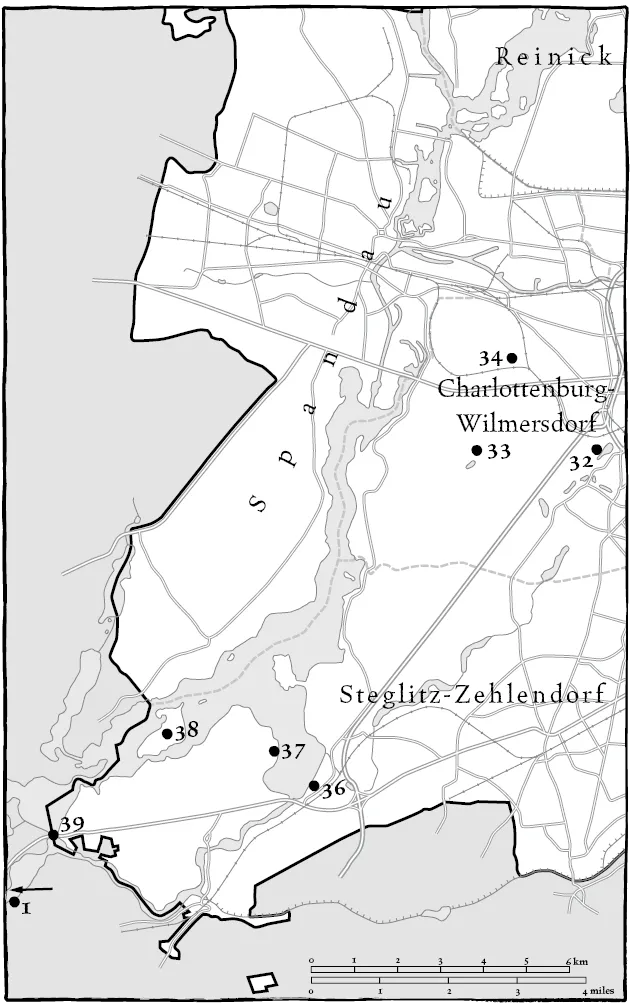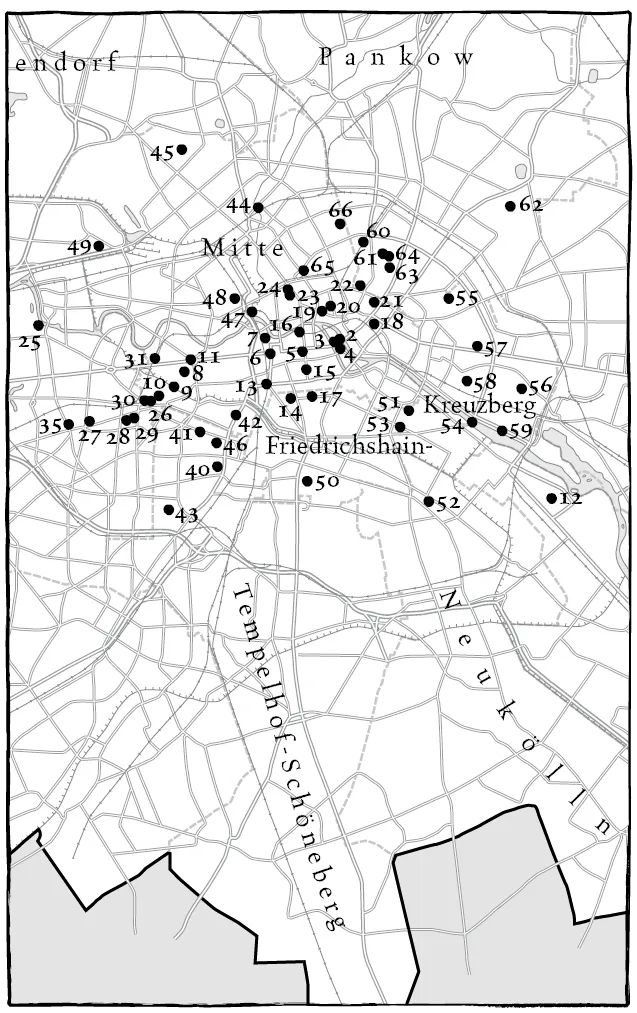![]()
Paul Sullivan’s journalism and photography work has been published in a variety of international publications including the Guardian, the Sunday Times, BBC Travel and more. He has written and contributed to over a dozen music and travel books for National Geographic, Time Out, Wallpaper, Rough Guides and Fodor’s, and runs the popular Berlin website www.slowtravelberlin.com, through which he publishes Berlin-themed books and runs cultural-historical tours through the city.
Marcel Krueger is a writer and translator whose articles and essays have been published in the Daily Telegraph, Süddeutsche Zeitung, CNN Travel, the Matador Network and more, and who also works as a local Berlin expert or ‘Spotter’ for Spotted by Locals. He divides his time between Berlin, Cologne and Dublin and together with Seamus Heaney, Roddy Doyle and a team of other great Irish writers Krueger also holds the world record for ‘Most Authors Reading Consecutively From Their Own Books’.
‘A rich and learned companion for every lover of Berlin; bursting with anecdote and alive with history. A must.’
Rory MacLean, author of Berlin: Imagine a City
Literary Guides for Travellers
Listed in Fathom’s 24 Best Indie Travel Guides
Andalucia by Andrew and Suzanne Edwards
Florence and Tuscany by Ted Jones
The French Riviera by Ted Jones
Scotland by Garry MacKenzie
Sicily by Andrew and Suzanne Edwards
Tangier by Josh Shoemake
Venice by Marie-José Gransard
Berlin
A Literary Guide for Travellers
Paul Sullivan and Marcel Krueger
Published in 2016 by
I.B.Tauris & Co. Ltd
London • New York
www.ibtauris.com
Copyright © 2016 Paul Sullivan and Marcel Krueger
The right of Paul Sullivan and Marcel Krueger to be identified as the authors of this work has been asserted by the author in accordance with the Copyright, Designs and Patents Act 1988.
All rights reserved. Except for brief quotations in a review, this book, or any part thereof, may not be reproduced, stored in or introduced into a retrieval system, or transmitted, in any form or by any means, electronic, mechanical, photocopying, recording or otherwise, without the prior written permission of the publisher.
Every attempt has been made to gain permission for the use of the images in this book. Any omissions will be rectified in future editions.
References to websites were correct at the time of writing.
ISBN: 978 1 78453 642 8
eISBN: 978 0 85772 864 7
ePDF: 978 0 85772 837 1
A full CIP record for this book is available from the British Library
A full CIP record is available from the Library of Congress
Library of Congress Catalog Card Number: available
Typeset by JCS Publishing Services Ltd, www.jcs-publishing.co.uk
Contents
List of Illustrations
Map
1 Introduction
2 Mitte: The Royal City
3 Alexanderplatz, the Scheunenviertel and the Spandauer Vorstadt
4 Charlottenburg
5 Grunewald and Wannsee
6 Schöneberg
7 Wedding and Moabit
8 Kreuzberg
9 Friedrichshain
10 Prenzlauer Berg
Chronology of Events
Select Bibliography
Illustrations
1 Berlin’s historic Altes Museum and Lustgarten
2 One of the city’s biggest icons, the Brandenburger Tor (Brandenburg Gate)
3 View across the Spree to the Reichstag and parts of the modernist Government Quarter (Regierungsviertel)
4 The modern skyscrapers that characterise today’s Potsdamer Platz
5 A socialist memorial appears to be grabbing the famous TV Tower (Fernsehturm) in Berlin-Mitte
6 Schloss Charlottenburg, one of the finest extant castles in Berlin
7 West Berlin’s most famous boulevard, the Kurfürsten-damm (Ku’damm)
8 S-Bahn Grunewald, the main gateway to the Grunewald Forest and also home to some significant memorials
9 The former Cold War spy station known as Teufelsberg (Devil’s Mountain)
10 The Luisenbad Library in Wedding
11 Moabit’s Prison Memorial
12 West Kreuzberg’s main drag, Bergmannstrasse
13 The Oberbaumbruecke, which connects the districts of Kreuzberg and Friedrichshain
14 Cherry trees in full bloom line a street that leads to Prenzlauer Berg’s Zionskirche
15 Spectators gather round the singers during a karaoke session at Prenzlauer Berg’s Mauerpark
All photographs are by Paul Sullivan, 2016
Introduction
Berlin is a young and unhappy city-in-waiting. There is something fragmentary about its history. Berlin’s frequently interrupted, still more frequently diverted or averted development has been checked and advanced, and by unconscious mistake as well as by bad intentions; the many obstacles in its path have, it would seem, helped it to grow.
(Joseph Roth, 1930)
Approached via air or land across the seemingly endless wooded plains of Brandenburg, Berlin manifests suddenly, almost magically: a brick-and-concrete apparition caught between lakes and forests. It seems to have no tangible connection to the surrounding landscape and feels similarly distanced from the mega-sprawl of western German cities such as Bonn, Cologne and Leverkusen, which creep into each other to form part of the Manchester–Milan axis.
This idea of an island-city fits Berlin well. It has always been more concerned with its own image and development than with looking too far beyond its borders, and its detachment has undoubtedly helped it serve as both canvas and laboratory over the centuries, drawing artists and dreamers, city planners and megalomaniacs. In turn, the rich blend of immigrants who have made the place home since its birth have ensured that the city has never remained static: in the famous words of arts historian Karl Scheffler, Berlin is a city ‘destined forever to become and never to be’.
In fact, the city literally began as an island; two, actually – Alt Berlin and Cölln – which lay side by side in the middle of the river Spree, roughly where the Museum Island, the Fisher Island and the Nikolaiviertel are located today. The surrounding landscape of Brandenburg, described in 1598 by travel writer and topographer Nicholas Leuthinger as a ‘flat land, wooded, and for the most part swamp’, meant that these riverside settlements, founded officially in the early thirteenth century and joined together in 1307, remained fairly obscure until the ambitious Hohenzollern dynasty entered the fray a couple of hundred years later.
In his book Berlin: Imagine a City (2014), Rory McLean paints a colourful picture of the city in medieval times:
[A] dirty patchwork of squalid hovels and mean manors stitched to a low, lazy twist of the Spree. Along its sandy banks fisher-boys hawked the morning catch, their high voices lifting in a kind of babbling river music. Brawny lads stripped to the waist unloaded barrels of Rhenish wine and sacks of rice from Arborio. A matron from a noble house craned her neck to select the finest trout, the freshest loaf, the thickest wedge of cheese, tucking each prize into her willow basket. Urchins raced by the Mühlendamm mills like dogs on a scent. Blue-tunicked soldiers sauntered through the mêlée, plucking any ware that took their fancy.
By 1618, the first year of the Thirty Years War that would devastate the city, Berlin still only had around 10,000 inhabitants compared to London’s 130,000. It was later in the seventeenth century, when Frederick William of Brandenburg, a.k.a. the Great Elector – the first to be named king in Prussia – worked to make Brandenburg-Prussia into a powerful northern German state, that Berlin began to gain more prominence. By the eighteenth century Frederick William I and his son Frederick the Great had managed to transform Prussia into a serious European power with an influence that far transcended its size.
As well as his renowned military victories, Frederick the Great – who ruled from 1740 until 1786 – was also famed for his patronage of the arts; as Kant once stated, he was more or less synonymous with the Enlightenment values that swept Europe during the eighteenth century. Frederick’s own liberal ideals were admirable: not only was he notoriously tolerant towards other religions, he also suspended the use of judicial torture in his lands – a huge step at the time. In terms of the arts, he eased up considerably on censorship too, even allowing his critics – and critical publications like The Berlin News (Die Berlinischen Nachrichten) – to live and operate in the city. Scottish travel writer and physician John Moore, who visited the city in 1775, wrote about this exceptionally liberal atmosphere:
Nothing surprised me more, when I first came to Berlin, than the freedom with which many people speak of the measure of government, and the conduct of the King. I have heard political topics, and others which I should have thought still more ticklish, discussed here with as little ceremony as at a London coffee house. The same freedom appears in the book sellers’ shops, where literary productions of all kinds are sold openly. The pamphlet lately published on the division of Poland, wherein the King is very roughly treated, is to be had without difficulty, as well as other performances, which attack some of the most conspicuous characters with all the bitterness of satire.
By the end of the eighteenth century there were some 200 clubs and societies throughout Prussia dedicated to reading and writing, not to mention a burgeoning selection of bookshops and l...










